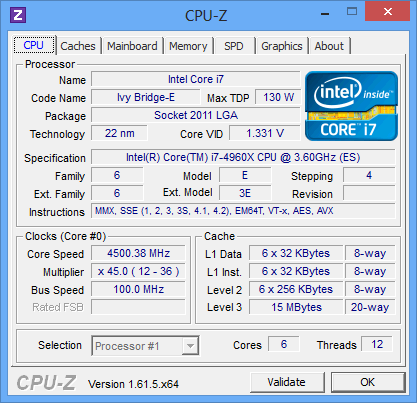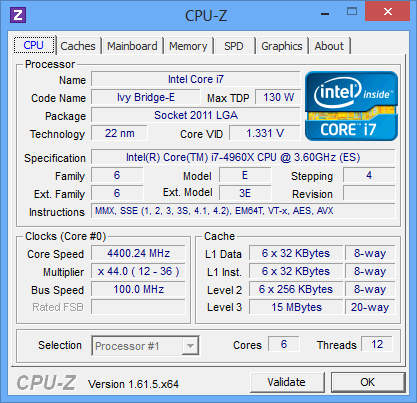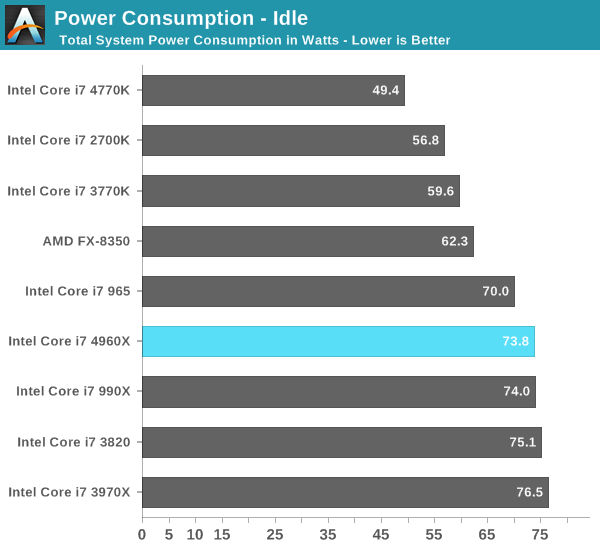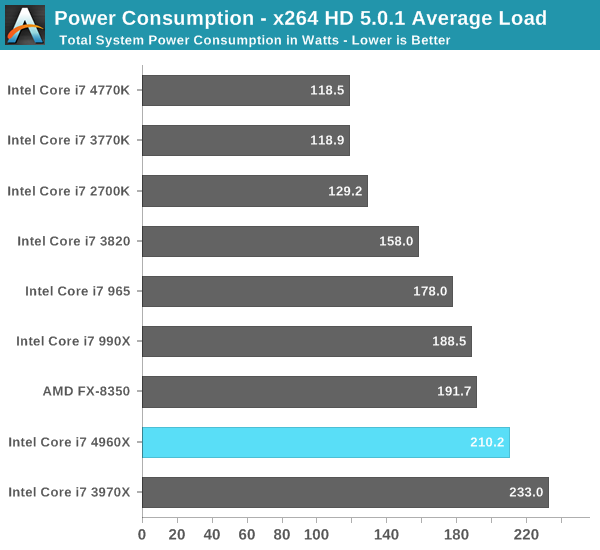Intel Core i7 4960X (Ivy Bridge E) Review
by Anand Lal Shimpi on September 3, 2013 4:10 AM EST- Posted in
- CPUs
- Intel
- Ivy Bridge
- Ivy Bridge-E
Overclocking
As I mentioned earlier, all of the IVB-E launch SKUs ship fully unlocked. Intel offers multipliers up to 63x for you to choose from when overclocking. Like SNB-E before it, IVB-E supports specific BCLK straps (125MHz and 166MHz, in addition to 100MHz) for those overclockers looking to get the absolute most out of their chip. At these overclocked BCLK frequencies, PCIe and other buses are properly divided down so they aren't overclocked (although if you increase the BCLK frequency beyond these strap defaults you will once again be overclocking other buses that derive their frequencies from BCLK). In practice, the cleanest/simplest way to overclock any K-series SKU is by increasing the multiplier.

In our review of the Core i7-3960X I managed a maximum stable overclock of 4.6GHz. I've been told to expect a similar average for Ivy Bridge E. Using Intel's RTS2011LC self contained/closed loop liquid cooling solution I could get into Windows 8 as high as 4.6GHz at 1.42V, however my testbed wasn't stable through all of my tests at that frequency/voltage combination. Moving to higher voltages didn't help, so I had to back down on frequency. I ultimately ended up perfectly stable at 4.3GHz, with 4.4 - 4.5GHz possible with better cooling. The added power needed to hit these frequencies was substantial. I measured a 58W increase in average load power consumption at 4.3GHz/1.4V.

From what I've seen, my sample is a bit on the disappointing side in terms of overclockability. Either way, it doesn't look like you're going to be seeing overclocks significantly higher than what was possible with SNB-E.
Power Consumption
With the 4960X delivering around 5% better performance than the 3970X, the only remaining question is how much more power efficient the move to 22nm made things. Using the same ASUS X79 Deluxe board for both parts, I was able to answer that question.
At idle there's hardly any difference between SNB-E and IVB-E. Under load it looks like IVB-E is good for around a 20W reduction in total system power. It's not an insignificant savings, but definitely not enough to warrant an upgrade if you're on SNB-E already. Anyone looking to migrate to LGA-2011 for the first time will want to go with IVB-E as it is the more thermally efficient solution.












120 Comments
View All Comments
Oscarcharliezulu - Friday, September 6, 2013 - link
This reminds me, of years ago when I had access to the first DEC Alpha with its super fast clock speed and fast IPC, a IBM AIX RS6000, a HP9000 PA-RISC and a multi-socket Sparc. The alpha was the fastest by a long way versus multi core even on our SAP systems. I still use this as a rule of thumb that for most tasks a faster clocked processor is better most of the time, except for very specific situations - and in general you will know what they are. I'm battling with what to do with my next upgrade, I really wanted a top end ivy-e but it really doesn't seem worth it compared to a 4770, even with my need to run big VM's. he'll its not enough faster than my i2500s ivy imac to be worth it.DPOverLord - Tuesday, September 10, 2013 - link
very interesting review coming from an i7-930 O/C to 4.3GHZ makes you debate if it makes sense to upgrade to the 4930K and a RIVE.For those considering there is also another benchmark review of the 3930K vs I7-930 on 2, 3, & 4 way TITAN SLI GK110 Scaling at 7680 x 1440 and 7680 x 1600. Worth a look.
DPOverLord - Tuesday, September 10, 2013 - link
very interesting review coming from an i7-930 O/C to 4.3GHZ makes you debate if it makes sense to upgrade to the 4930K and a RIVE.overclock.net/t/1415441/7680x1440-benchmarks-plus-2-3-4-way-sli-gk110-scaling/0_100
For those considering there is also another benchmark review of the 3930K vs I7-930 on 2, 3, & 4 way TITAN SLI GK110 Scaling at 7680 x 1440 and 7680 x 1600. Worth a look.
Remarius - Wednesday, September 11, 2013 - link
Really useful - I missed that thread somehow.Fierce Guppy - Saturday, September 14, 2013 - link
Should nVidia's shadowplay turn out to be rubbish then I could use that CPU for encoding recorded gameplay, otherwise there's no benefit in having a 4960X over a 4770K. It won't improve my gaming experience any. Two GTX 780s will do that.scorpyclone - Tuesday, September 24, 2013 - link
This is a great article for informing us about the latest and greatest architecture and chips, anyway I too have stuck with my powerhouse system since 2006, mine is the Q9550 and P35 mobo, DDR2 second generation SSD and so forth!It has been rock solid and frankly I don't think I remember the last time it crashed, come to think of it it has never crashed! (...and I am able to have all my progs running plus 30 plus instances of chrome, yeah I should do something about that!)
So there you have it, now i m looking at the LGA 2011 with X79 and maybe (If i can convince myself of the benefits of having a six core system) an i7 4920 or40, ...but will probably go with their 4 core 10 or 12 meg cache cpus...the difference in having 2 more cores is 200 bux! I don't have any problem spending 3 bills on a nice CPU, but when it comes to 2 more bills just to get 2 more cores, I really cant convince myself of that, since i can think of so many other ways to spend those two bills with more return so to speak!
So yeah building a powerhouse of a system that costs a little more but is rock solid and still faster than 90 percent of what is out there is worth it for me, and I am sure others will say the same!
Or maybe I can just get the better P45 chipset, and stick with this system for another two to three years!
Laphaswiff - Monday, December 9, 2013 - link
δοκοῦσι δέ μοι Λακεδαιμόνιοι μάλα δεινῶν ἔργον ἀνθρώπων ποιεῖν. νῦν γάρ φασιν ἐκεῖνοι δεῖν Ἠλείους μὲν τῆς Τριφυλίας τινὰ κομίσασθαι, Φλειασίους δὲ τὸ Τρικάρανον, ἄλλους δέ τινας τῶν Ἀρκάδων τὴν αὑτῶν, καὶ τὸν Ὠρωπὸν ἡμᾶς, οὐχ ἵν' ἑκάστους ἡμῶν ἴδωσιν ἔχοντας τὰ αὑτῶν, οὐδ' ὀλίγου δεῖ· (17) ὀψὲ γὰρ ἂν φιλάνθρωποι γεγονότες εἶεν· ἀλλ' ἵνα πᾶσι δοκῶσι συμπράττειν, ὅπως ἕκαστοι κομίσωνται ταῦθ', ἅ φασιν αὑτῶν εἶναι, ἐπειδὰν δ' ἴωσ' ἐπὶ Μεσσήνην αὐτοί, συστρατεύωνται πάντες αὐτοῖς οὗτοι καὶ βοηθῶσι προθύμως, ἢ δοκῶσ' ἀδικεῖν, περὶ ὧν ἔφασαν ἕκαστοι σφῶν αὐτῶν εἶναι συμψήφους λαβόντες ἐκείνους, μὴ τὴν ὁμοίαν αὐτοῖς χάριν ἀποδιδόντες.SeanFL - Wednesday, January 15, 2014 - link
I edit video from time to time and am currently using an i7-2600k system built in May of 2011. I've been looking at the 6 core i7-3930k, but not sure if it provides enough of an increase to build a new system. Are we closer to an 8 core solution coming out under $1000 in 2014? What's on the way?SeanFL - Wednesday, January 15, 2014 - link
typo, meant looking at the i7-4930k. Still wondering, is 8 core under $1k on the way this year?MordeaniisChaos - Thursday, April 17, 2014 - link
You guys should really, really include ArmA as a benchmark for CPU gaming performance, as it sees pretty much constant improvements as the CPU gets more potent. I do not understand why more sites don't use A3 for CPU benchmarking when they touch on gaming performance.